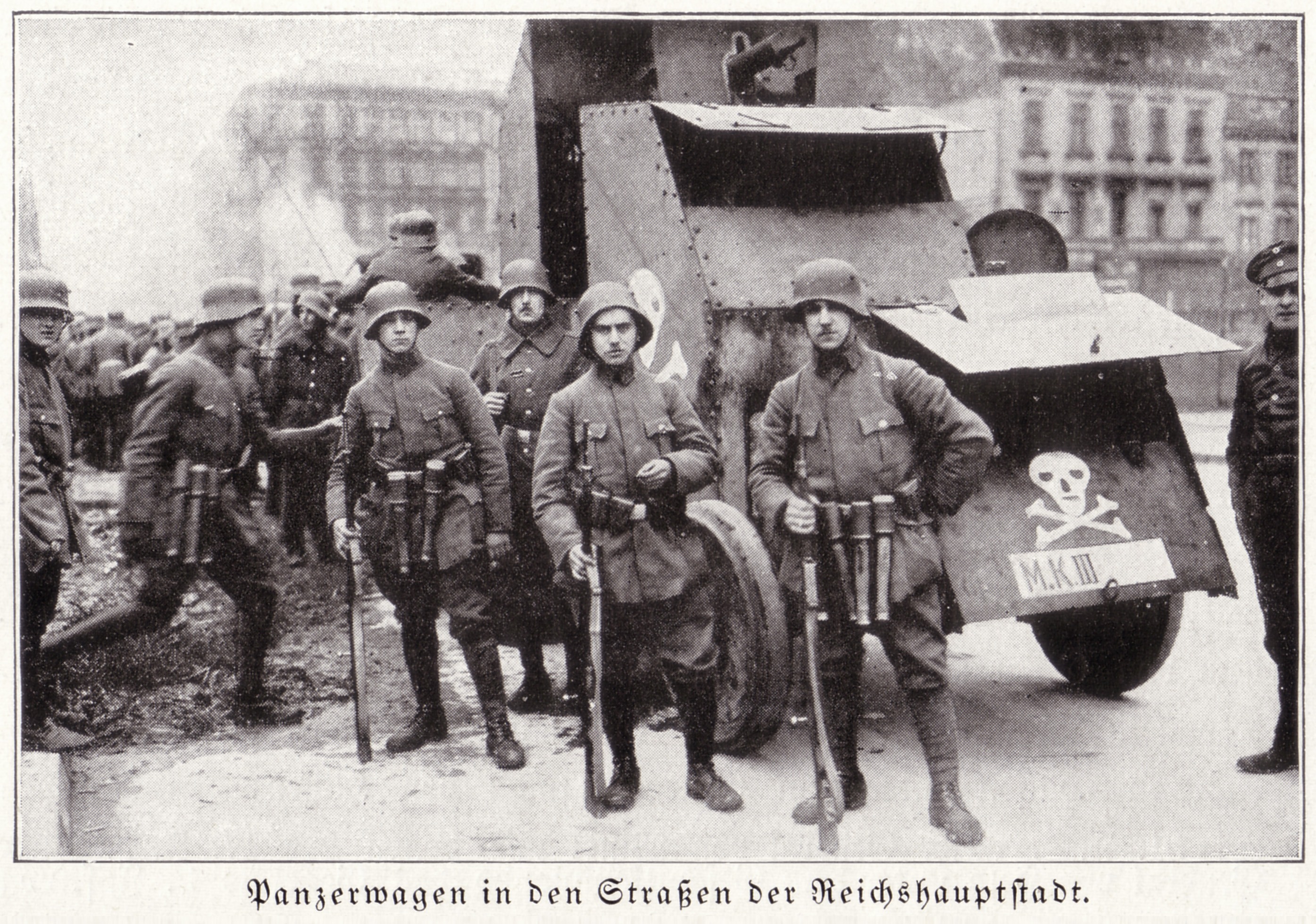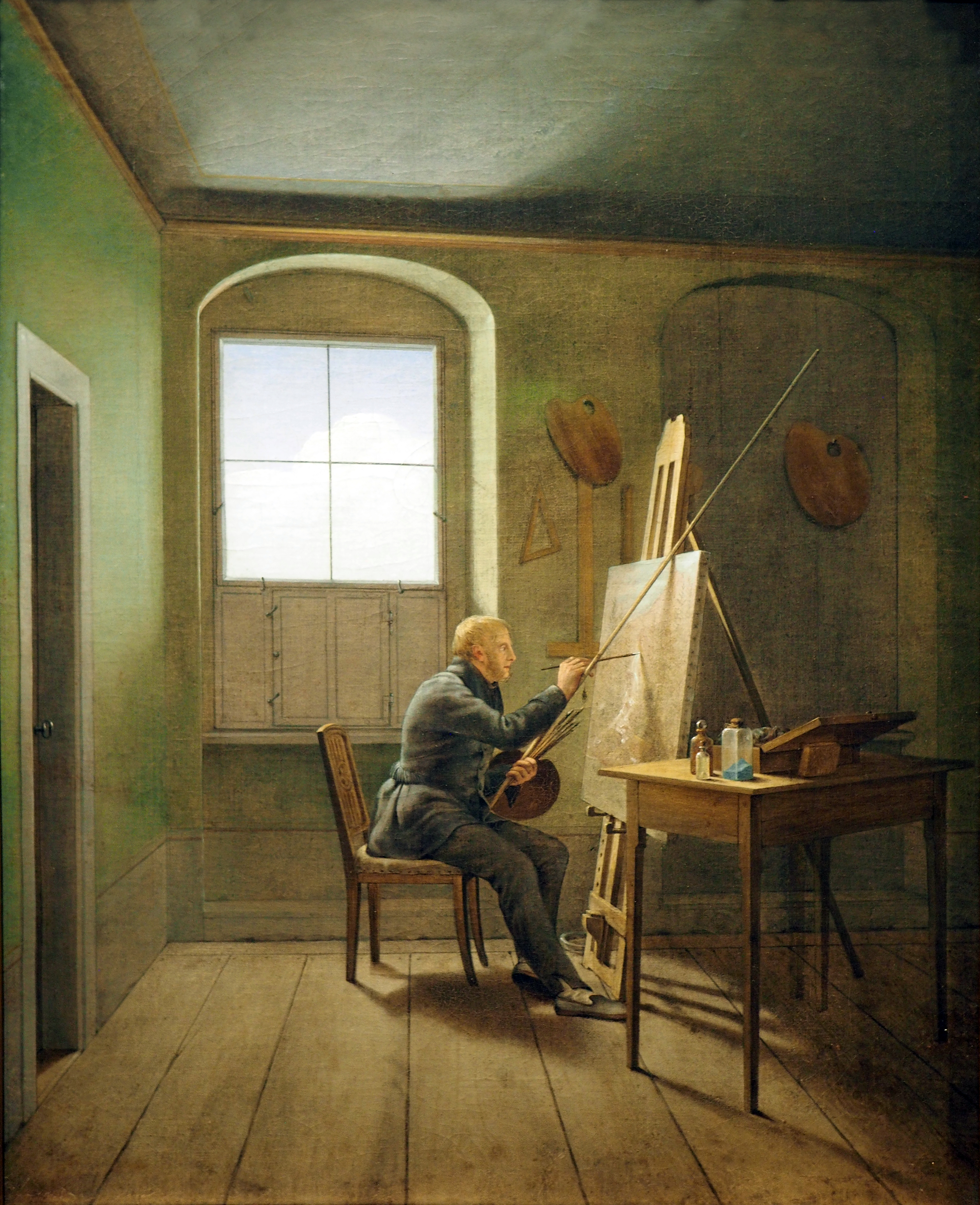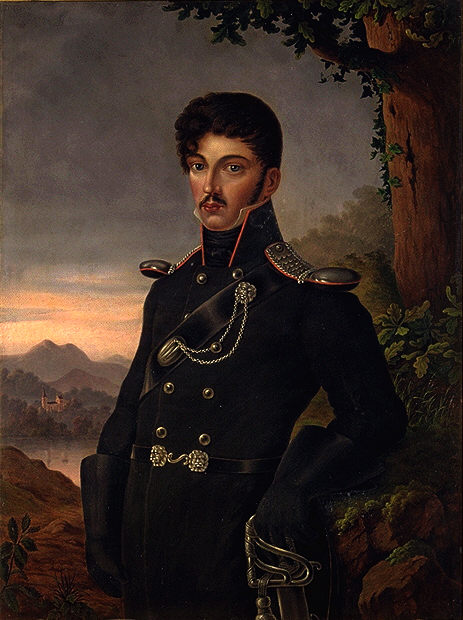|
Georg Friedrich Kersting
Georg Friedrich Kersting (31 October 1785 – 1 July 1847) was a German painter, best known for his Biedermeier-style interior paintings and his association with fellow artist Caspar David Friedrich. Biography Kersting came from a large and impoverished family in Güstrow, Mecklenburg-Schwerin, the son of a glazier. He studied at the progressive Copenhagen Academy between 1805 and 1808, where he adapted the visual clarity of the contemporary Danish schoolLife of Georg Friedrich Kersting . Lib-Art. Retrieved on 24 March 2008. and was awarded a silver medal in draughtsmanship. Kersting moved to Dresden in 1808, joining the —a voluntary force of the |
Gerhard Von Kügelgen
Franz Gerhard von Kügelgen (6 February 1772 – 27 March 1820) was a German painter, noted for his portraits and history paintings. He was a professor at the Dresden Academy of Fine Arts and a member of both the Prussian and Russian Imperial Academies of Arts. His twin brother, Karl von Kügelgen, was also a painter of note. Biography He was born at Bacharach am Rhein. After leaving school in 1789, he studied painting in Koblenz. Beginning in 1791, he worked in Bonn, where he painted portraits of Elector Archduke Maximilian Francis of Austria, minister Ferdinand August von Spiegel zum Desenberg, and the Count of Waldstein. Afterwards, he and his brother undertook an educational journey to Rome, Munich and Riga, which was financed by Archduke Maximilian In 1800, he married Helene Marie Zoege von Manteuffel (1774–1842); from a noble Baltic-German family with roots in the 14th century. They had three children together. His first son, Wilhelm, was born in Saint Petersburg i ... [...More Info...] [...Related Items...] OR: [Wikipedia] [Google] [Baidu] |
Staffage
In painting, staffage () are the human and animal figures depicted in a scene, especially a landscape, that are not the primary subject matter of the work. Typically they are small, and there to add an indication of scale and add interest. Before the adoption of the word into the visual arts in the late eighteenth and early nineteenth centuries, ''Staffage'' in German could mean "accessories" or "decoration". The word can be used in two senses: as a general term for any figures in a work, even when they are, at least ostensibly, the main subject, and as a descriptive term for figures to whom no specific identity or story is attached, included merely for compositional or decorative reasons. In the latter sense, staffage are accessories to the scene, yet add life to the work; they provide depth to the painting and reinforce the main subject, as well as giving a clear scale to the rest of the composition. During the Baroque, painters such as Nicolas Poussin and Claude Lorrain commo ... [...More Info...] [...Related Items...] OR: [Wikipedia] [Google] [Baidu] |
19th-century German Painters
The 19th (nineteenth) century began on 1 January 1801 ( MDCCCI), and ended on 31 December 1900 ( MCM). The 19th century was the ninth century of the 2nd millennium. The 19th century was characterized by vast social upheaval. Slavery was abolished in much of Europe and the Americas. The First Industrial Revolution, though it began in the late 18th century, expanding beyond its British homeland for the first time during this century, particularly remaking the economies and societies of the Low Countries, the Rhineland, Northern Italy, and the Northeastern United States. A few decades later, the Second Industrial Revolution led to ever more massive urbanization and much higher levels of productivity, profit, and prosperity, a pattern that continued into the 20th century. The Islamic gunpowder empires fell into decline and European imperialism brought much of South Asia, Southeast Asia, and almost all of Africa under colonial rule. It was also marked by the collapse of the large S ... [...More Info...] [...Related Items...] OR: [Wikipedia] [Google] [Baidu] |
Prussian Army Personnel Of The Napoleonic Wars
Prussia, , Old Prussian: ''Prūsa'' or ''Prūsija'' was a German state on the southeast coast of the Baltic Sea. It formed the German Empire under Prussian rule when it united the German states in 1871. It was ''de facto'' dissolved by an emergency decree transferring powers of the Prussian government to German Chancellor Franz von Papen in 1932 and ''de jure'' by an Allied decree in 1947. For centuries, the House of Hohenzollern ruled Prussia, expanding its size with the Prussian Army. Prussia, with its capital at Königsberg and then, when it became the Kingdom of Prussia in 1701, Berlin, decisively shaped the history of Germany. In 1871, Prussian Minister-President Otto von Bismarck united most German principalities into the German Empire under his leadership, although this was considered to be a "Lesser Germany" because Austria and Switzerland were not included. In November 1918, the monarchies were abolished and the nobility lost its political power during the ... [...More Info...] [...Related Items...] OR: [Wikipedia] [Google] [Baidu] |
Freikorps Personnel Of The Napoleonic Wars
(, "Free Corps" or "Volunteer Corps") were irregular German and other European military volunteer units, or paramilitary, that existed from the 18th to the early 20th centuries. They effectively fought as mercenary or private armies, regardless of their own nationality. In German-speaking countries, the first so-called ("free regiments", Freie Regimenter) were formed in the 18th century from native volunteers, enemy renegades, and deserters. These, sometimes exotically equipped, units served as infantry and cavalry (or, more rarely, as artillery); sometimes in just company strength and sometimes in formations of up to several thousand strong. There were also various mixed formations or legions. The Prussian included infantry, jäger, dragoons and hussars. The French '' Volontaires de Saxe'' combined uhlans and dragoons. In the aftermath of World War I and during the German Revolution of 1918–19, consisting largely of World War I veterans were raised as paramili ... [...More Info...] [...Related Items...] OR: [Wikipedia] [Google] [Baidu] |
1847 Deaths
Events January–March * January 4 – Samuel Colt sells his first revolver pistol to the U.S. government. * January 13 – The Treaty of Cahuenga ends fighting in the Mexican–American War in California. * January 16 – John C. Frémont is appointed Governor of the new California Territory. * January 17 – St. Anthony Hall fraternity is founded at Columbia University, New York City. * January 30 – Yerba Buena, California, is renamed San Francisco. * February 5 – A rescue effort, called the First Relief, leaves Johnson's Ranch to save the ill-fated Donner Party (California-bound emigrants who became snowbound in the Sierra Nevada earlier this winter; some have resorted to survival by cannibalism). * February 22 – Mexican–American War: Battle of Buena Vista – 5,000 American troops under General Zachary Taylor use their superiority in artillery to drive off 15,000 Mexican troops under Antonio López de Santa Anna, defeating the Mexicans the next day. * ... [...More Info...] [...Related Items...] OR: [Wikipedia] [Google] [Baidu] |
1785 Births
Events January–March * January 1 – The first issue of the ''Daily Universal Register'', later known as ''The Times'', is published in London. * January 7 – Frenchman Jean-Pierre Blanchard and American John Jeffries travel from Dover, England to Calais, France in a hydrogen gas balloon, becoming the first to cross the English Channel by air. * January 11 – Richard Henry Lee is elected as President of the U.S. Congress of the Confederation.''Harper's Encyclopaedia of United States History from 458 A. D. to 1909'', ed. by Benson John Lossing and, Woodrow Wilson (Harper & Brothers, 1910) p167 * January 20 – Battle of Rạch Gầm-Xoài Mút: Invading Siamese forces, attempting to exploit the political chaos in Vietnam, are ambushed and annihilated at the Mekong River, by the Tây Sơn. * January 27 – The University of Georgia in the United States is chartered by the Georgia General Assembly meeting in Savannah. The first students are ad ... [...More Info...] [...Related Items...] OR: [Wikipedia] [Google] [Baidu] |
Caspar David Friedrich In His Studio
''Caspar David Friedrich in his Studio'' refers to two paintings by the German romanticism, German romantic artist Georg Friedrich Kersting dated 1811 and 1819. Of these the 1819 version is the best known. In both Kersting depicted fellow German painter Caspar David Friedrich in his studio. The picture shows the painter leaning on the back of a chair, focused entirely upon the easel before him. It is not possible for the viewer to see what the artist sees, because only the back of the canvas is visible. Friedrich, apparently lost in thought, holds in his right hand a brush, and in his left a mahlstick, Palette (painting), palette, and several other brushes. The studio is ascetically bare containing only two other palettes, a straightedge and a t-square hanging on the wall. Hamburg version In the Hamburg Kunsthalle version (1811) Friedrich is seated before his easel, painting, with his arm leaning on the mahlstick. In this version the viewer shares his view of the painting, which ... [...More Info...] [...Related Items...] OR: [Wikipedia] [Google] [Baidu] |
Theodor Körner (author)
Carl Theodor Körner (23 September 1791 – 26 August 1813) was a German poet and soldier. After some time in Vienna, where he wrote some light comedies and other works for the Burgtheater, he became a soldier and joined the Lützow Free Corps in the German uprising against Napoleon. During these times, he displayed personal courage in many fights, and encouraged his comrades by fiery patriotic lyrics he composed, among these being the "Schwertlied" (Sword Song), composed during a lull in fighting only a few hours before his death, and "Lützows wilde Jagd" (Lützow's Wild Chase, or Hunt), each set to music by both Carl Maria von Weber and Franz Schubert. He was often called the "German Tyrtaeus." Early life He was born at Dresden, capital of the Saxon electorate, the son of the consistorial councillor Christian Gottfried Körner and his wife Minna Stock Körner. He was raised by his parents and by his aunt, the artist Dora Stock, who lived in the home. He attended the Kreuzsc ... [...More Info...] [...Related Items...] OR: [Wikipedia] [Google] [Baidu] |
Ferdinand Hartmann
Christian Ferdinand Hartmann (14 July 1774, Stuttgart – 6 January or June 1842, Dresden) was a German portrait and Classical history painter. Biography He was the youngest son of the Ducal finance councilor, and his wife Juliane Friederike née Spittler (1736–1799), daughter of the Mayor of Cannstatt. Three of his brothers also became well-known: , a State Councilor, , a paleontologist, and , an industrial entrepreneur. His father's home was also a literary salon, frequented by many notable writers, including Goethe, Friedrich Schiller, Schiller and Friedrich Hölderlin, Hölderlin. From 1786 to 1794, he studied painting at the Hohe Karlsschule in Stuttgart. He spent the years 1794 to 1798 in Rome, on a study trip, where his choice of style was influenced by Asmus Carstens. Upon returning, he became a member of the State Academy of Fine Arts Stuttgart, State Academy of Fine Arts. From 1803 to 1809, he was in the employ of Princess Louise of Brandenburg-Schwedt, in Dresde ... [...More Info...] [...Related Items...] OR: [Wikipedia] [Google] [Baidu] |
Dutch Golden Age Painting
Dutch Golden Age painting is the painting of the Dutch Golden Age, a period in Dutch history roughly spanning the 17th century, during and after the later part of the Eighty Years' War (1568–1648) for Dutch independence. The new Dutch Republic was the most prosperous nation in Europe and led European trade, science, and art. The northern Netherlandish provinces that made up the new state had traditionally been less important artistic centres than cities in Flanders in the south. The upheavals and large-scale transfers of population of the war, and the sharp break with the old monarchist and Catholic cultural traditions, meant that Dutch art had to reinvent itself almost entirely, a task in which it was very largely successful. The painting of religious subjects declined very sharply, but a large new market for all kinds of secular subjects grew up. Although Dutch painting of the Golden Age is included in the general European period of Baroque painting, and often shows many o ... [...More Info...] [...Related Items...] OR: [Wikipedia] [Google] [Baidu] |
Charles Augustus
Karl August, sometimes anglicised as Charles Augustus (3 September 1757 – 14 June 1828), was the sovereign Duke of Saxe-Weimar and of Saxe-Eisenach (in personal union) from 1758, Duke of Saxe-Weimar-Eisenach from its creation (as a political union) in 1809, and grand duke from 1815 until his death. He is noted for the intellectual brilliance of his court.Ulich, Robert, ''The Education of Nations'', Harvard University Press, Cambridge, Mass. 1961, p.193 Biography Born in Weimar, he was the eldest son of Ernst August II, Duke of Saxe-Weimar and Saxe-Eisenach (Ernest Augustus II), and Duchess Anna Amalia of Brunswick-Wolfenbüttel. His father died when he was only nine months old (28 May 1758), and the boy was brought up under the regency and supervision of his mother. His governor was the Count Johann Eustach von Görtz and in 1771, Christoph Martin Wieland was appointed his tutor. In 1774 the poet Karl Ludwig von Knebel came to Weimar as tutor to his brother, the young Prince F ... [...More Info...] [...Related Items...] OR: [Wikipedia] [Google] [Baidu] |










